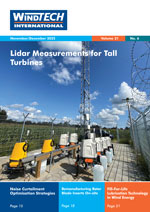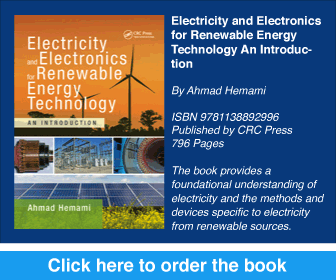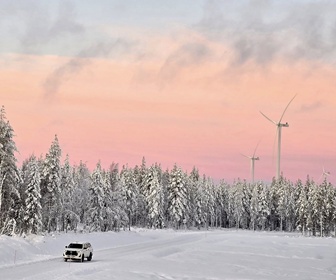- Category: Articles
Targets and Benefits
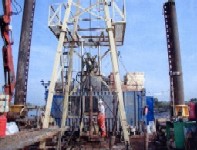 Time and cost benefits can be achieved by the imaginative use of a broad range of services for geotechnical and geophysical data gathering for offshore wind farm sites. Today, there is a comprehensive range of services available to acquire engineering data for the planning, installation and post-construction monitoring of offshore wind farm structures. Applied systematically, each stage of investigation will add to the understanding of the ground model for the site and will help to fine-tune and target the requirements for any subsequent investigations.
Time and cost benefits can be achieved by the imaginative use of a broad range of services for geotechnical and geophysical data gathering for offshore wind farm sites. Today, there is a comprehensive range of services available to acquire engineering data for the planning, installation and post-construction monitoring of offshore wind farm structures. Applied systematically, each stage of investigation will add to the understanding of the ground model for the site and will help to fine-tune and target the requirements for any subsequent investigations.
By Tony Hodgson, Project Manager, Fugro Engineering Services and Ed Cookson, Heathrow Communications, UK
.
 Time and cost benefits can be achieved by the imaginative use of a broad range of services for geotechnical and geophysical data gathering for offshore wind farm sites. Today, there is a comprehensive range of services available to acquire engineering data for the planning, installation and post-construction monitoring of offshore wind farm structures. Applied systematically, each stage of investigation will add to the understanding of the ground model for the site and will help to fine-tune and target the requirements for any subsequent investigations.
Time and cost benefits can be achieved by the imaginative use of a broad range of services for geotechnical and geophysical data gathering for offshore wind farm sites. Today, there is a comprehensive range of services available to acquire engineering data for the planning, installation and post-construction monitoring of offshore wind farm structures. Applied systematically, each stage of investigation will add to the understanding of the ground model for the site and will help to fine-tune and target the requirements for any subsequent investigations.By Tony Hodgson, Project Manager, Fugro Engineering Services and Ed Cookson, Heathrow Communications, UK
- Category: Articles
Their Use in Key Areas of Turbine Operation
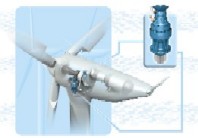 In order to achieve their design potential as credible alternative providers of energy, wind turbine systems have to employ highly efficient, reliable and robust components. Among the most important of these components are gearboxes; in particular, planetary gearboxes. One of the manufacturers of planetary gearboxes is Brevini. This article describes the company’s activities within this field.
In order to achieve their design potential as credible alternative providers of energy, wind turbine systems have to employ highly efficient, reliable and robust components. Among the most important of these components are gearboxes; in particular, planetary gearboxes. One of the manufacturers of planetary gearboxes is Brevini. This article describes the company’s activities within this field.
By Luca Bortolani, Technical Communication and Web Marketing Manager, Brevini Riduttori, Italy
.
 In order to achieve their design potential as credible alternative providers of energy, wind turbine systems have to employ highly efficient, reliable and robust components. Among the most important of these components are gearboxes; in particular, planetary gearboxes. One of the manufacturers of planetary gearboxes is Brevini. This article describes the company’s activities within this field.
In order to achieve their design potential as credible alternative providers of energy, wind turbine systems have to employ highly efficient, reliable and robust components. Among the most important of these components are gearboxes; in particular, planetary gearboxes. One of the manufacturers of planetary gearboxes is Brevini. This article describes the company’s activities within this field.By Luca Bortolani, Technical Communication and Web Marketing Manager, Brevini Riduttori, Italy
- Category: Articles
A Tool for Monitoring White-Fronted Goose Movements
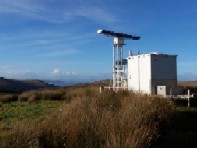 The UK government now has ambitious targets for the overall contribution of renewable energy to the UK’s energy budget. These higher targets have resulted in an increase in applications for onshore and offshore renewable energy developments. In the UK, many of the renewable resources with the most potential are at their greatest in Scotland. This has of course created some conflict, in particular with respect to wind generation, because of Scotland’s remote habitats and the species of conservation concern, including key bird species, that use these areas. Therefore, developers and statutory bodies have been pressed to seek state of the art assessment methods for accurately gauging potential environmental impacts.
The UK government now has ambitious targets for the overall contribution of renewable energy to the UK’s energy budget. These higher targets have resulted in an increase in applications for onshore and offshore renewable energy developments. In the UK, many of the renewable resources with the most potential are at their greatest in Scotland. This has of course created some conflict, in particular with respect to wind generation, because of Scotland’s remote habitats and the species of conservation concern, including key bird species, that use these areas. Therefore, developers and statutory bodies have been pressed to seek state of the art assessment methods for accurately gauging potential environmental impacts.By Richard Walls and Mark Parnel, Bird Management Unit, Central Science Laboratory (CSL), UK
.
- Category: Articles
More Sustainable Financing of Wind Power Projects through Improved Annual Energy Production Estimates
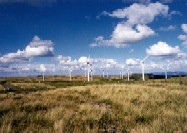 This article is about increasing confidence levels in annual energy production calculations for proposed wind farms. To do this, Sinclair Knight Merz uses detailed statistical analysis of the measured site data and the measured meteorological station data, without assuming a certain correlation function between the two datasets before the analysis has taken place.
This article is about increasing confidence levels in annual energy production calculations for proposed wind farms. To do this, Sinclair Knight Merz uses detailed statistical analysis of the measured site data and the measured meteorological station data, without assuming a certain correlation function between the two datasets before the analysis has taken place.By Paul van Lieshout, Wind Power Group Manager, Sinclair Knight Merz (Europe) Ltd, UK
- Category: Articles
Dry-Type Transformers versus High Temperature Liquid-Filled Transformers
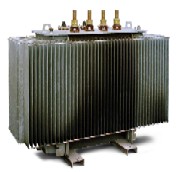 New turbines above 3MW are being developed at a rapid rate in order to maximise energy yields. Therefore turbine components also have to be upgraded. A transformer is required to step up the voltage from the generator (400 to 3000V) to a medium voltage level. Safety and fire behaviour of transformers is an important issue for our industry. Fire damage accounts for between 9 and 20% of wind power insurance claims. In this article, the authors compare the safety and fire behaviour of dry-type transformers with high temperature liquid-filled transformers.
New turbines above 3MW are being developed at a rapid rate in order to maximise energy yields. Therefore turbine components also have to be upgraded. A transformer is required to step up the voltage from the generator (400 to 3000V) to a medium voltage level. Safety and fire behaviour of transformers is an important issue for our industry. Fire damage accounts for between 9 and 20% of wind power insurance claims. In this article, the authors compare the safety and fire behaviour of dry-type transformers with high temperature liquid-filled transformers.By Jan Declercq and Raymond Van Schevensteen, Pauwels International NV, Belgium
.
- Category: Articles
Expanding the Speed Range with the Doubly-Fed Induction Generator
Developments in power electronics, electrical drives and wind turbines have allowed an increase in the power of wind systems. The need to limit mechanical stress and power disturbances has led to strong demand for variable speed systems. In wind generation systems it is necessary to decouple and control active and reactive power flow with fast response because of mains requirements. Fast and accurate control is especially important when the induction machine is designed to operate below synchronism rotational speed as a generator. This article describes a controller that can extract power from wind kinetic energy over a large speed range, at both sub- and hyper-synchronism speeds.
By Paulo Costa, António Martins and Adriano Carvalho, Portugal
.
By Paulo Costa, António Martins and Adriano Carvalho, Portugal
- Category: Articles
Development of a Methodology for Wind Resource Assessment
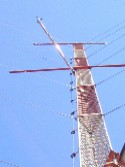 Since 1995, COPEL (the local utility of the State of Paraná, Brazil) has been developing, in partnership with LACTEC and CAMARGO SCHUBERT, research and development projects in the area of wind energy. In 1999, the project named ‘Projeto VENTAR’ introduced the ‘Wind energy resource map of the State of Paraná’. In line with the global growth of renewable energy utilisation, and the beginning of the Brazilian wind energy market, COPEL has developed a methodology to support feasibility analyses of wind farm projects in Brazil. The author gives a description of the methodology and results achieved.
Since 1995, COPEL (the local utility of the State of Paraná, Brazil) has been developing, in partnership with LACTEC and CAMARGO SCHUBERT, research and development projects in the area of wind energy. In 1999, the project named ‘Projeto VENTAR’ introduced the ‘Wind energy resource map of the State of Paraná’. In line with the global growth of renewable energy utilisation, and the beginning of the Brazilian wind energy market, COPEL has developed a methodology to support feasibility analyses of wind farm projects in Brazil. The author gives a description of the methodology and results achieved.
By Luiz Procopiak, LACTEC, Brazil
.
 Since 1995, COPEL (the local utility of the State of Paraná, Brazil) has been developing, in partnership with LACTEC and CAMARGO SCHUBERT, research and development projects in the area of wind energy. In 1999, the project named ‘Projeto VENTAR’ introduced the ‘Wind energy resource map of the State of Paraná’. In line with the global growth of renewable energy utilisation, and the beginning of the Brazilian wind energy market, COPEL has developed a methodology to support feasibility analyses of wind farm projects in Brazil. The author gives a description of the methodology and results achieved.
Since 1995, COPEL (the local utility of the State of Paraná, Brazil) has been developing, in partnership with LACTEC and CAMARGO SCHUBERT, research and development projects in the area of wind energy. In 1999, the project named ‘Projeto VENTAR’ introduced the ‘Wind energy resource map of the State of Paraná’. In line with the global growth of renewable energy utilisation, and the beginning of the Brazilian wind energy market, COPEL has developed a methodology to support feasibility analyses of wind farm projects in Brazil. The author gives a description of the methodology and results achieved.By Luiz Procopiak, LACTEC, Brazil



